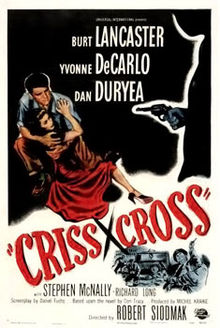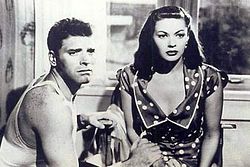- Criss Cross (film)
-
Criss Cross 
Theatrical release posterDirected by Robert Siodmak Produced by Michael Kraike Screenplay by Daniel Fuchs
William Bowers (uncredited)Based on Don Tracy Starring Burt Lancaster
Yvonne De Carlo
Dan DuryeaMusic by Miklós Rózsa Cinematography Franz Planer Editing by Ted J. Kent Distributed by Universal International Pictures Release date(s) January 12, 1949
(United States)Running time 87 minutes Country United States Language English Criss Cross is a 1949 film noir, directed by Robert Siodmak from a novel of the same name by Don Tracy. This black-and-white film was shot partly on location in the Bunker Hill section of Los Angeles. The film was written by Daniel Fuchs. Franz Planer's cinematography creates a black-and-white film noir world. Miklós Rózsa scored the film's soundtrack.[1] The film was remade as The Underneath in 1995.[2].
The production nearly derailed when producer Mark Hellinger died suddenly before filming began. Lancaster claimed he was unhappy with the way Siodmak and Fuchs had reworked Hellinger's idea of a racetrack heist into a fatal romantic triangle.
Contents
Plot
Reuniting with director Siodmak after their success with Ernest Hemingway's The Killers, Burt Lancaster plays Steve Thompson, a man who seals his dark fate when he returns to Los Angeles to find his ex-wife Anna Dundee (Yvonne DeCarlo) eager to rekindle their love against all better judgment.
She encourages their affair but then quickly marries mobster Slim Dundee (Dan Duryea). To deflect suspicion of the affair, Steve Thompson leads Dundee into a daylight armored-truck robbery, only to be "criss crossed" when the crime is pulled off.
Cast
- Burt Lancaster as Steve Thompson
- Yvonne De Carlo as Anna Dundee
- Dan Duryea as Slim Dundee
- Stephen McNally as Det. Lt. Pete Ramirez
- Esy Morales and His Rhumba Band
- Tom Pedi as Vincent
- Percy Helton as Frank
- Alan Napier as Finchley
- Griff Barnett as Pop
- Meg Randall as Helen
- Richard Long as Slade Thompson
- Joan Miller as The Lush
- Edna Holland as Mrs. Thompson
- John Doucette as Walt
- Marc Krah as Mort
Background
Criss Cross features the screen debut of Tony Curtis (then known as James Curtis). Curtis plays De Carlo's dance partner in a key scene at the Round-Up Bar. Once the dance ends, he disappears from both scene and film. Curtis was chosen by the director after many young hopefuls had auditioned for the part. The song Curtis and De Carlo dance to is called "Jungle Fantasy" and is performed by Esy Morales who also makes a cameo appearance in this scene.
Locations
Like many films noir, Criss Cross was shot around downtown Los Angeles, beginning with the opening panorama from a helicopter that ends at a nightclub just north of downtown. Lancaster's character lives with his mother at a house on Hill Street, just above the north entrance of the short Hill Street Tunnel (at Temple Street). (Hill Street was actually both the tunnel and the street running above it in what was called the Court Hill section. Court Hill, between First and Temple Streets, was a fork of Bunker Hill that ran east almost to Broadway.) The tunnel and the hill above it (including the house) were razed in 1955 for expansion of the Civic Center and a new Los Angeles County Courthouse on Hill Street, which can often be seen in episodes of Perry Mason. For the planning of the heist, Siodmak used the exterior and interiors of the rambling, rundown Sunshine Apartments on the steep Third Street steps between Hill and Olive, just opposite the funicular Angels Flight, which we see going up and down in the background through the windows of the hotel room. This area of Bunker Hill was a favorite of noir directors, and unfortunately it was all torn down in the 1960s. There is also an extended scene inside and outside Union Station on Alameda.
Critical reception
When released, The New York Times gave the film a mixed review, writing, "A tough, mildly exciting melodrama about gangsters and a dame named Anna who 'gets into the blood' of a guy named Steve and causes him no end of trouble...In many ways Criss Cross is a suspenseful action picture, due to the resourceful directing of Robert Siodmak. But it also is tedious and plodding at times, due partly to Mr. Siodmak's indulgence of a script that is verbose, redundant and imitative. However, the writers should be credited with having invested the old triangle-gangster formula with a couple of fresh if not exactly revolutionary twists."[3]
Film critic Dennis Schwartz recently wrote, "Robert Siodmak ...directs this cynical film noir of obsessive love and betrayal. It's 1940s film noir at its most influential as far as style goes, that is further enhanced by the beautiful dark photography of Frank Planer, the tight script by Daniel Fuchs, and the taut pacing by Siodmak. It's based on a story by Don Tracy...Siodmak keeps the suspense at a feverish pitch, and the characterizations are well drawn out. Criss Cross is one of the great examples of 1940s film noir at its most tragic. A must see film for fans of the genre."[4]
Dave Kehr, film critic for the Chicago Reader, lauded the film and wrote, "Robert Siodmak was one of the most influential stylists of the 40s, helping to create, in films such as Phantom Lady and The Killers, the characteristic look of American film noir. But most of his films have nothing more than their pictorial qualities to recommend them--Criss Cross being one of the few exceptions, an archly noir story replete with triple and quadruple crosses, leading up to one of the most shockingly cynical endings in the whole genre."[5]
The review aggregator Rotten Tomatoes reported that 100% of critics gave the film a positive review, based on eight reviews.[6]
Adaptation
The film was remade as The Underneath directed by Steven Soderbergh in 1995.[2]
Awards
Nomination
- Edgar Allan Poe Awards: Edgar, Best Motion Picture, Daniel Fuchs and Don Tracy (novel); 1950.
See also
References
- ^ Criss Cross at the Internet Movie Database.
- ^ a b The Underneath at the Internet Movie Database
- ^ The New York Times. Film review, "Burt Lancaster Same Old Tough Guy," March 12, 1949. Last accessed: March 22, 2008.
- ^ Schwartz, Dennis. Ozus' World Movie Reviews,. film review, October 26, 2004. Last accessed: March 23, 2008.
- ^ Kehr, Dave. Chicago Reader, film review, 1996-2008. Last accessed: March 23, 2008.
- ^ Criss Cross at Rotten Tomatoes. Last accessed: March 23, 2008.
External links
- Criss Cross at the Internet Movie Database
- Criss Cross at Rotten Tomatoes
- Criss Cross at AllRovi
- Criss Cross at the TCM Movie Database
- Criss Cross trailer at TCM Media Room
Films directed by Robert Siodmak Europe
1930-1939People on Sunday · Abschied · Der Mann, der seinen Mörder Sucht · Voruntersuchung · Sturme der Leidenschaft · Le Sexe faible · Quick · Brennendes Geheimnis · La Crise est finie · La Vie parisienne · Cargaisons blanches · Mollenard · PiegesHollywood
1941-1952West Point Widow · Fly-by-Night · My Heart Belongs to Daddy · The Night Before the Divorce · Someone to Remember · Son of Dracula · Phantom Lady · Cobra Woman · Christmas Holiday · The Suspect · The Strange Affair of Uncle Harry · The Spiral Staircase · The Killers · The Dark Mirror · Time Out of Mind · Cry of the City · Criss Cross · The Great Sinner · The File on Thelma Jordon · Deported · The Whistle at Eaton Falls · The Crimson PirateEurope
1954-1969Flesh and the Woman · Die Ratten · Mein Vater, der Schauspieler · The Devil Came at Night · Katia · Dorothea Angermann · The Rough and the Smooth · Der Schulfreund · L'Affaire Nina B. · Escape from East Berlin · Der Schut · Der Schatz der Azteken · Die Pyramide des Sonnengottes · Custer of the West · Kampf um Rom I · Kampf um Rom IICategories:- English-language films
- 1949 films
- 1940s crime films
- American films
- Black-and-white films
- Crime drama films
- Film noir
- Films based on novels
- Films directed by Robert Siodmak
- Heist films
- Universal Pictures films
Wikimedia Foundation. 2010.

